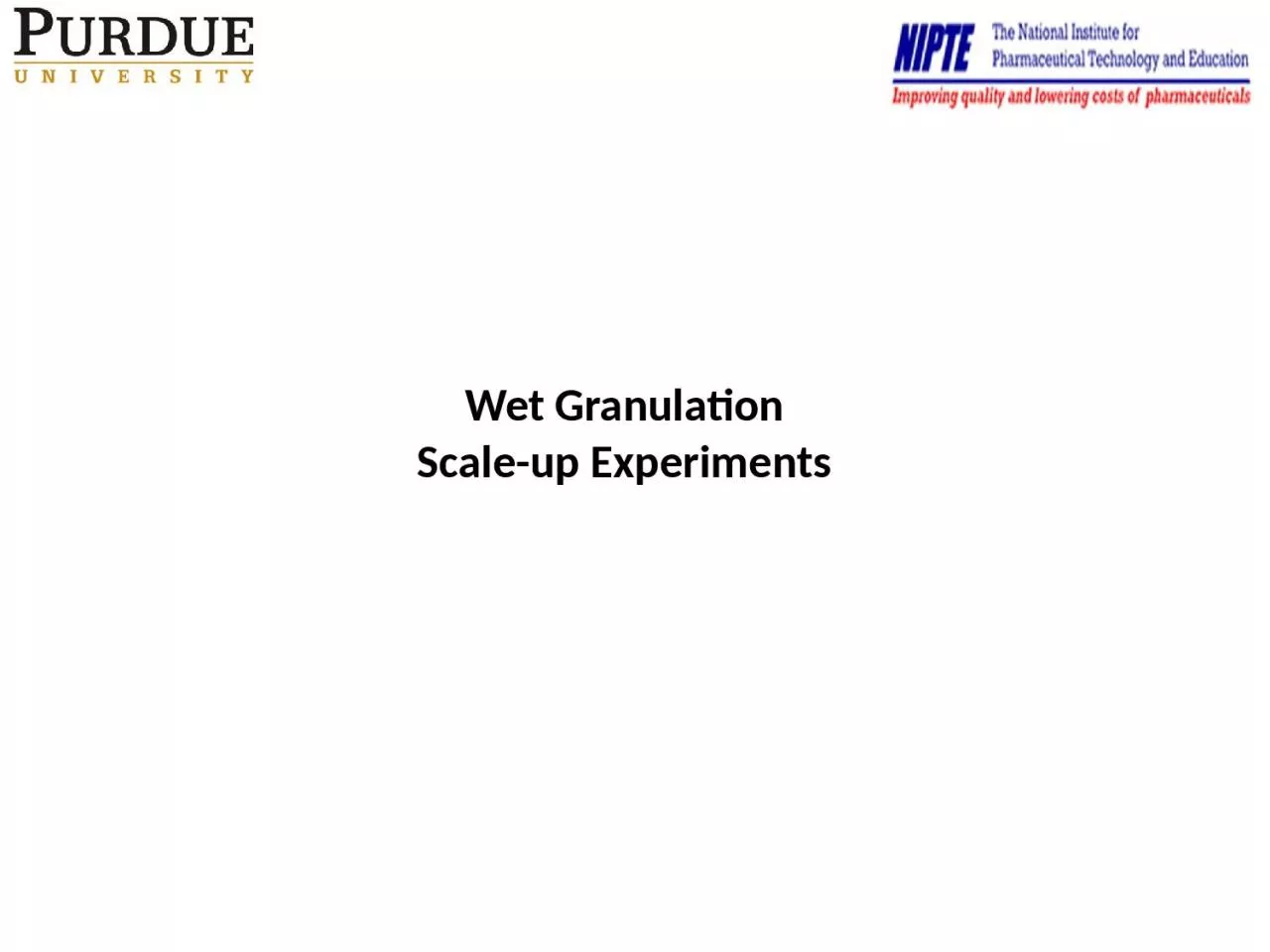

Scaleup Approach with Dimensional Numbers 2 The effect of process parameter ie impeller speed liquid addition rate on the process and thus on granule characteristics are evaluated based on mechanistic understanding ID: 933765
Download Presentation The PPT/PDF document "Wet Granulation Scale-up Experiments" is the property of its rightful owner. Permission is granted to download and print the materials on this web site for personal, non-commercial use only, and to display it on your personal computer provided you do not modify the materials and that you retain all copyright notices contained in the materials. By downloading content from our website, you accept the terms of this agreement.
Slide1
Wet GranulationScale-up Experiments
Slide2Scale-up Approach with Dimensional Numbers
2 The effect of process parameter (i.e., impeller speed, liquid addition rate) on the process and thus on granule characteristics are evaluated based on mechanistic understanding.
Use dimensional numbers as variables rather than individual process parameters. This will decrease the number of variables need to be varied, thus the number of experiments (
includes explicitly includes liquid addition rate, implicitly includes impeller speed and liquid addition mode).
Determine the design space at the smallest scale for the given formulation based on dimensional numbers and validate the design space for larger scales with less experiments compared to DOE approach.
Crumb
Nucleation
Steady Growth
Induction
Rapid Growth
Slide3Design of Scale-up Experiments3
Optimum conditions from Duquesne University Wet Granulation experiments:Liquid content :5 %Liquid addition rate :15 ml/minImpeller Speed :500 rpm Wet massing time :30 sec
The liquid percentage is kept same as the smallest scale experiments. The sensitivity to liquid amount is tested around the optimum liquid level that was obtained at small scale.
Slide4Design of Scale-up ExperimentsRatio of fill height to granulator diameter at all scales should be kept constant.
4
Granulator size
4 l
10 l
75 l
Granulation Batch Size (kg)
0.6
1
9.72
Diameter of the granulator bowl (cm)
17
24.6
52.5
Fill height / Diameter
0.27
0.15
0.15
Slide5Design of Scale-up ExperimentsThe spraying time and the dimensionless spray flux need to be kept constant.
5
4 l =
0.11
For
constant spraying
time, the
values for larger scales with
single nozzle
are calculated assuming 100 m drop size
:
10 l
=
0.15 and 0.18
(Close
to small scale
)
75 l
=
0.34
and
0.50
(Too
high compare to small
scale, therefore higher amounts of
lumps should be expected.
Can be
lowered by using two nozzles)
Slide6Design of Scale-up ExperimentsImpeller speed was scaled according to constant tip speed and constant Froude number (Fr) rules (provided that the impeller speed is above the critical Froude number for constant tip speed rule.
6
Constant Fr:
Constant tip speed:
N: Impeller speed
D: Impeller diameter
4 l
500 rpm
10 l
340 rpm
420 rpm
const. tip speed
const. Fr
const. Fr
const. tip speed
75 l
195 rpm
290 rpm
Slide7Intermediate Scale (10 l)7
Batch
Impeller Speed (rpm)
Liquid Content (% of liquid amount to solid amount)
Liquid Addition Rate (g/min)
Liquid addition time (sec)
Wet Massing Time (sec)
a
Median Particle Size (µm)
% of lumps (> 1 mm)
96251-1
420
6
28.5
126
30
0.15
-
-
96251-2
420
5
28.5
105
30
0.15
280
1.58
96251-3
420
3
28.5
63
30
0.15
175
0.20
96251-4
420
4
28.5
84
30
0.15
220
0.69
96251-5
340
4
28.5
84
30
0.18
201
0.20
96251-6
340
4
249.6
10
30
0.18
207
1.08
96251-7
420
4
249.6
10
30
0.15
212
0.90
96251-8
420
5
28.5
105
60
0.15
286
2.02
96251-9
420
5
28.5
105
0
0.15
275
3.91
96251-10
420
5
28.5
105
30
0.15
277
4.04
96251-11
420
5
28.5
105
30
0.15
283
2.00
96251-12
420
5
28.5
105
30
0.15
297
2.94
96251-13
420
5
28.5
105
30
0.15
302
2.32
96251-14
420
5
28.5
105
30
0.15
289
3.02
96251-15
420
5
28.5
105
30
0.15
293
2.11
Slide8Effect of Liquid Content8
Slide9SummaryLump formation is low due to the low drop penetration time and low dimensional spray flux. The granulation material is easy to process at low liquid contents ( < 6%), not large clumps are formed, but the whole mixture become very sticky if the critical moisture content is exceeded.
The formulation seem to be insensitive to most of the operating conditions with the given fill ratio, granulator geometry, and drying conditions and analysis methods.9
Slide10Large Scale (75 l)10
Batch
Impeller Speed (rpm)
Liquid Content (% of liquid amount to solid amount)
Liquid Addition Rate (g/min)
Liquid addition time (sec)
Wet Massing Time (sec)
a
Median Particle Size (µm)
% of lumps (>1 mm)
96251-21
290
5
277
105
30
0.34
272
10.80
96251-22
290
5
277
105
30
0.34
284
13.52
96251-23
195
5
277
105
30
0.50
280
10.28
96251-24
290
5
277
105
30
0.34
422
33.51
96251-25
290
4
277
84
30
0.34
250
9.56
96251-27
195
5
277
105
30
0.50
301
17.8
Slide11Comparison of PSDs- 10 l and 75 l11
Slide12SummaryAlthough the median particle sizes matches with the 10 l scale, the amount of lumps are much higher at 75 l due to the doubled dimensional spray flux.Further analysis of Stdef and S
max is needed to evaluate the effects of liquid amount and impeller speed on the PSD.12